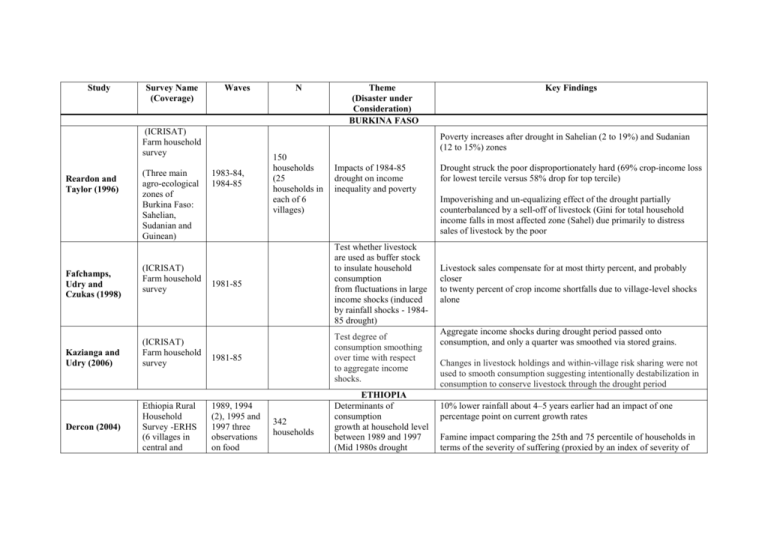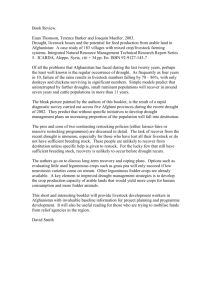Summary table: Case studies from Africa
advertisement

Study Survey Name (Coverage) Waves (ICRISAT) Farm household survey Reardon and Taylor (1996) Fafchamps, Udry and Czukas (1998) Kazianga and Udry (2006) Dercon (2004) (Three main agro-ecological zones of Burkina Faso: Sahelian, Sudanian and Guinean) (ICRISAT) Farm household survey (ICRISAT) Farm household survey Ethiopia Rural Household Survey -ERHS (6 villages in central and N Theme (Disaster under Consideration) BURKINA FASO Key Findings Poverty increases after drought in Sahelian (2 to 19%) and Sudanian (12 to 15%) zones 1983-84, 1984-85 150 households (25 households in each of 6 villages) Impacts of 1984-85 drought on income inequality and poverty Impoverishing and un-equalizing effect of the drought partially counterbalanced by a sell-off of livestock (Gini for total household income falls in most affected zone (Sahel) due primarily to distress sales of livestock by the poor 1981-85 Test whether livestock are used as buffer stock to insulate household consumption from fluctuations in large income shocks (induced by rainfall shocks - 198485 drought) 1981-85 Test degree of consumption smoothing over time with respect to aggregate income shocks. 1989, 1994 (2), 1995 and 1997 three observations on food 342 households Drought struck the poor disproportionately hard (69% crop-income loss for lowest tercile versus 58% drop for top tercile) ETHIOPIA Determinants of consumption growth at household level between 1989 and 1997 (Mid 1980s drought Livestock sales compensate for at most thirty percent, and probably closer to twenty percent of crop income shortfalls due to village-level shocks alone Aggregate income shocks during drought period passed onto consumption, and only a quarter was smoothed via stored grains. Changes in livestock holdings and within-village risk sharing were not used to smooth consumption suggesting intentionally destabilization in consumption to conserve livestock through the drought period 10% lower rainfall about 4–5 years earlier had an impact of one percentage point on current growth rates Famine impact comparing the 25th and 75 percentile of households in terms of the severity of suffering (proxied by an index of severity of south Ethiopia0 Dercon, Hoddinott and Woldehana (2005) consumption (1989, 1994/5 and 1997) and two growth rates for each households 1999-2004 (2 waves) Dercon and Christiaensen (2006) 1994-99 Dercon and Krishnan (2000) 1994 (2), 1995 1984-85 Famine) coping strategies), the latter had about 4 to 16 percentage points lower growth in the 1990s It took on average ten years for livestock holdings in the 75 percentile to recover to the levels seen before the 1984-85 famine. 1,447 households 467 households 1,477 households 1999 drought and 2002 drought shocks to households experienced between 1999 and 2004 Impact of shocks on (log) consumption per capita Impact of the risk of poor consumption outcomes on the adoption and use of fertiliser Village-level rainfall during the period considered Determinants of changes in body mass index over a short horizon, with special attention to farmspecific index of rainfall experiences on the farm, such as whether plowing occurred too early or too late for the rains, whether it rained when harvesting, etc Experiencing a drought at least once in the previous five years lowers per capita consumption by about 20 percent. Uninsured drought during the period increased poverty under a third (14%). Reporting a serious drought shock in the last two years is correlated with 16 percent lower consumption, while a shock in the preceding two years is still reducing consumption by 14 percent Fertiliser use was significantly lower for those with higher consumption risk due to drought. Moving households up in the consumption distribution at the 10th percentile by one standard deviation would result in 44 percent more Rainfall shocks affect Body Mass Index: relatively poor rainfall in some communities lowered BMI by about 0.9 per cent for households with low land holdings Drought increased asset poor households from 60 to 78 percent Little et al. (2007) Lybbert et al. (2004) Yamano, Alderman and Christiaensen (2005) Barrett et al. (2007) BASIS/IDR Household survey (South Wollo and Oromiya Zones in northeast Ethiopia) Herd histories (Selected pastoralists from southern Ethiopia) Welfare Monitoring Survey (WMS); the Food Security Survey (FSS) and the 1995/96 Annual Agricultural Sample Survey US Agency for International Development (USAID) panel (Rural northern Kenya) 1997-2003 (7 waves) 416 households Impact of 1999-2000 drought on poverty dynamics 1980-1997 55 households Measure resistance to droughts as a function of herd size. 1995-1996 (6 month interval between rounds) March 2000June 2002 (quarterly) 2,414 children under five year old spread over 469 EAs out of 531. 177 households Impact of weather shocks and food aid on children growth in 1995-1996 KENYA Determine if poverty traps exist when households start with limited initial wealth or when they suffer a serious shock to the stock or productivity of their assets 95% of asset destitute households (with one or fewer TLU) remained poor after six years. Beyond eight TLUs most stayed out of poverty despite the drought. Evidence of poverty traps with asset (not consumption) smoothing amongst the poorest. Also high recovery rates, but below material poverty threshold: average livestock asset for bottom quartile grew from 0.17 in 2000 to 1.85 TLUs in 2003. For the poorest households annual growth rates of about 0.3 TLU/year, would still take 8-10 years to reach 4.5 TLU per household. Having a large herd of 45-75 cattle at the beginning of a drought helps to smooth consumption and ensure a reasonable herd size after a drought, but having below 45 prevents households from diversifying income sources rendering them vulnerable to shocks. Children aged between six to twenty four months loose about 0.9 cm growth over a six month interval compared to those residing in communities where the damaged crop area was 50% lower. Same group of age grew 1.8 percent faster in food aid receiving communities, yet food aid receptions has been largely determined by factors others than shocks. Among the poorest households mean inter-temporal income variability is less than mean expenditure variability, proving that the most vulnerable destabilise consumption to protect livestock (crucial productive asset) Uninsured risk (including natural hazards) leads to lower returns per unit of wealth (livestock) observed in a lower Coefficient of Variation of income among poorer households. Among pastoralists in northern Kenya, the variability of household expenditures exceeds that of income below a dynamic asset poverty threshold, but not above it. The poor manage their herds to smooth assets, not consumption. Beegle, de Weerdt and Dercon (2006) Dercon (1996) Alderman et al. (2006) Kagera Health and Development Survey (KHDS) (Kagera region in North-West Tanzania) (Shinynaga district, Western Tanzania) Bill Kinsey data 1991, 1992, 1993, 1994, 2004 900 households in 1991-94, all households and split-offs in 2004 (2,774 households) TANZANIA Assess how crop-related shocks affect both short and long run consumption growth of household (serious agricultural crop shocks related to pests and drought) Relationship between risk behaviour and household wealth 1990 Consequence of crop portfolio choice over income 1983/84, 1987, annually 1992-2002 400 households ZIMBABWE Impact on children aged 12-24 months during drought in their heightfor-age and other outcomes during adolescence and adulthood (and this on grades of schooling and age at which children start school and loss of future earnings) Crop shocks going back to 1991 lead to consumption growth losses with point estimates of between 17 and 40 percent. Shift into low risk activities for poorest quintile relative to the richest resulted in 20 percent lower incomes per unit of land A household with an average livestock holding allocates 20 percent less of its land to sweet potatoes (low drought-risk low return crop) than a household with no liquid assets. The crop portfolio of the wealthiest quintile yields 25 percent more per adult than that of the poorest quintile. Children affected by drought experienced a loss of stature (2.3 centimetres) in late adolescence; delays in school enrolment (3.7 months) and reduction in grade completion (0.4 grades) 13 to 16 years after the droughts; also 14 percent loss of lifetime earnings. Hoddinott and Kinsey (2001) Hoddinott (2006) (1982-84 drought) Drought impact on preschoolers (12-24 months) heights (1994-95 drought) Bill Kinsey data Bill Kinsey data 1994-99 (annual data) 400 households Test differences in coping behaviour by asset levels and assess the impact of 1994-95 drought within household members Calibrate a growth model that account for risk and risk responses Elbers and Gunning (2003) 1.5 and 2 cm lower annual height growth rates relative to control group. Pre-drought asset levels affect likelihood of asset smoothing (More than 50% of households with more than 2 oxen sold at least 1 while only 15% of households with 1 or 2 oxen did so). Above preservation of physical assets appears to cause temporary reduction in women’s health (women BMI fell) and also permanent effects on children’s human capital, especially amongst the poorest: .12-24 months preschoolers lost 15-20 growth velocity due to drought, and those residing in poorest household did not recovered. Exposure to risk reduces growth (capital stock is reduced by more than 40 percent). Two-thirds of this loss is due to ex-ante strategies by which households try to minimize the impact of risk (build up of livestock holdings to cope with consumption risk). COTE D’IVOIRE Jensen (2000) Cotê d’Ivoire Living Standards Survey, a household-level survey collected annually between 1985 and 1988 1986-1987 (annual) 1,600 households (1986) and 1,579 households (1987) Impact of rainfall shocks on education and health investments (1986, 1987 rainfall shocks) School enrolment rates decline by 14 and 11 percentage points among boys and girls (respectively) living in areas that experience a rainfall shock and increased in all other areas. Overall school enrolment rates decline 20% in the shock regions relative to children in the non-shock regions. The impact of the shock for boys and girls are nearly identical. The percentage of sick children taken for consultation declines to around 1/3 for those who received the negative shock and increased slightly for boys in regions with normal rainfall.






